RealViz Stitcher, perhaps the best program available for patching together multiple images to produce a master high resolution wide angle master shot. We talk to RealViz Product manager Stephane Negri about Stitcher 5, and examine its relationship to Photoshop.
Stitcher:
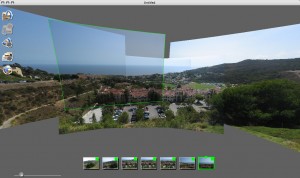
One tool that is used in addition to Photoshop by many Digi-matte artists is Stitcher. Films such as the recent Bewitched, used the software to feed the digital artists with high resolution accurate panoramas. We spoke to the Stephane Negri the Stitcher Product Manager in France about how the tool has developed and especially the latest version Stitcher 5.
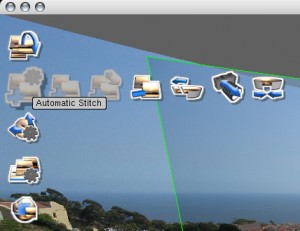
fxg: I would like to discuss the new menus in Stitcher 5 – why change? What has the reaction been from users?
SN: We decided to change the whole interface to give the user a greater sense of ‘immersion’. In the old version of Stitcher on the Mac, for example, you had 3 different windows, now everything is in one. It makes things much simpler for the user, and enables them to work in full-screen mode. Sure, the change has surprised some older customers, but after taking a closer look people get used to it quickly & recognize the benefits of this change.
Stitcher is one of the few products on the market, which can create a full spherical panorama from any type of camera and lenses, the only exception is the fisheye lens for patent reasons. It’s also important to point out, that Stitcher is not only a ‘Stitching’ program, but that it also comes with a lot of tools, which really help the user workflow: for example, the Stencil Tool which enables you to directly draw polygons within the software to exclude certain parts of the images, or the Conversion Tool which can convert from almost any kind of panorama to any other format. The broad range of export formats is also a real plus compared with other products
fxg: Is there an option to hide the menus from being over the image?
SN: Yes, that was a request from our users. You can actually remove everything with the ‘Vanish’ command. Down the line we will also add the possibility to just hide the menus.
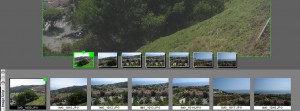
fxg: With the images now along the bottom of the main window – why do we still need a separate “image strip” window?
SN:Stitcher 5 is the first version with the new interface, so we decided to keep the “image strip”, which is familiar to our older users, to allow a smoother transition to the new look.

fxg: Could you explain the new Snapshot output option – what is it rendering out?
SN: The Snapshot output option is, in fact, exactly the same as the “old” Planar one. We renamed it, because we received feedback from some users who did not understand the meaning of “planar”. So the Snapshot output option is a planar projection of what you can see within your 3D view.
fxg: Has there been any discussion of extending Stitcher to HDR ? Either with an automated multiple exposure load – or just stitching Open EXR files ?
SN: Maybe both, and maybe even more… HDR is a pretty hot topic today, and obviously needs to be considered as an important new direction for Stitcher. At the moment, we’re still analyzing user requirements. At the moment, you cannot save a HDR format image/panorama with Stitcher. But if you want to blend different exposures you just have to “stitch” the different exposures in Stitcher and render the final image. Stitcher will blend everything together. Some of our customers are actually already producing HDR panoramas using Stitcher, with a work-flow that is described on Greg Downing’s site click here.
The HDR topic is not mature enough for us to lay-out the right specs in a snap. But something will certainly happen in the relatively close future with Stitcher and HDR.
fxg: Earlier versions of Stitcher often needed large stitches to have the component images not too large – but in the new version it seems to load larger images without problems, has the memory management been improved?
SN:Dealing efficiently with very large images in terms of memory is always a challenge. With each new version, we try to improve this aspect as far as we possibly can. It’s something that we worked on a great deal for this latest version and we’re also looking at different ways to improve this in future versions as well.
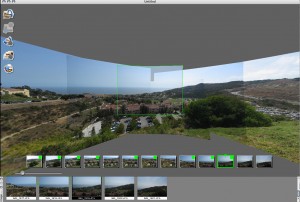
fxg: feature that makes Stitcher shine over say Photoshop CS is the equalizing and blending modes – Stitcher will produce seamless sky patches where other programs will be very patchy and the changes in luminance levels will not be adjust for… Can you discuss the way you so brilliantly solve this problem?
SN: Stitcher analyzes all the images before equalizing and tries to match the image luminosity of paired images instead of all the images, so that the local transition tends to be seamless.
fxg: Stitcher 5 on the Mac is / was extremely buggy .. can you comment on this – or on fix release?
SN: Both platforms share the same code and benefit from the same global changes and improvements. We listen to our customers very carefully, and if a bug is detected, we do our best to correct these ASAP. A patch (5.03) is currently available for download from our website at www.realviz.com, which corrects most of the initial bugs which came to light in the first release of version 5.
fxg: What’s next at RealViz generally?
SN: In Spring 2006, REALVIZ will launch a brand-new product, currently named, VTour. VTour combines the technology of Stitcher & ImageModeler, and will offer users of all levels an innovative and effective solution for the creation of photo-real 3D virtual tours. VTour is currently in Beta testing will launch in a week or so.
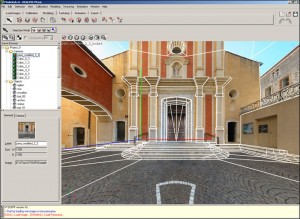
Starting directly from digital photographs, or from full 360 degree panoramas (created using Stitcher, for example), VTour facilitates the creation of 3D scenes such as interiors (rooms, buildings…etc) or urban areas (places, streets…etc), using polygonal photo-textured primitives. The results can be exported/ published as either a 3D movie, or as an interactive application using 3D viewers such as Macromedia Shockwave Player or Virtools Web Player.
VTour has been specifically developed for use in a wide range of applications, such as virtual walkthroughs inside buildings and monuments, 3D simulation, virtual reality, urban planning and video games, and is also well suited for the creation of virtual sets for film and television. VTour thus ideally complements StoryViz, REALVIZ’ 3D previz and story-boarding software, enabling users to create photo-real backdrops for their previsualisation projects.
